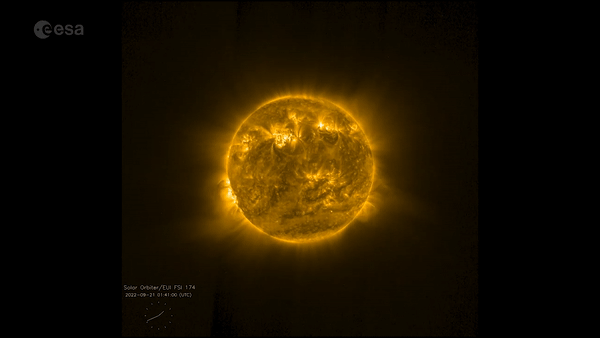Watch a 'solar snake' slither across sun's surface ahead of massive eruption
The snake is a stream of cooler plasma squeezed between magnetic field lines.
The European Solar Orbiter spacecraft watched an odd snake-like filament crawl across the sun's surface just before a massive plasma eruption.
The filament originated in a sunspot, a cooler region on the sun's surface where the star's magnetic field is twisted. The "snake" took three hours to slither across the sun's disk at a speed of 105 miles (170 kilometers) per second, or 378,000 mph (608,000 km/h) according to a statement from the European Space Agency (ESA), which operates the spacecraft. In the time-lapse sequence constructed from images captured by Solar Orbiter's Extreme Ultraviolet Imager, the "snake" glides across the disk within a second.
Because the odd occurrence was followed by a coronal mass ejection (CME), an eruption of hot plasma from the sun's upper atmosphere, the corona, scientists think the two phenomena might be connected.
Related: ESA's Solar orbiter just got smacked by a coronal mass ejection

The plasma of the snake was cooler than its surroundings as it made its way through the convoluted magnetic field lines emanating from the star's surface, ESA officials wrote in the statement.
"You're getting plasma flowing from one side to the other but the magnetic field is really twisted," David Long, a scientist at Mullard Space Science Laboratory of University College London, U.K., who led the investigation into the phenomenon, said in the statement. "So you're getting this change in direction because we're looking down on a twisted structure."
Particles from the subsequent eruption, which took place on Sept. 5, were later detected by Solar Orbiter's Energetic Particle Detector (EPD). According to the ESA statement, the eruption was "one of the most intense solar energetic particle events" detected by the instrument since it began scanning its surroundings after the spacecraft launched in 2020.
Get the Space.com Newsletter
Breaking space news, the latest updates on rocket launches, skywatching events and more!
"It's a really nice combination of datasets that we only get from Solar Orbiter," Long said.
NASA's Parker Solar Probe, which periodically approaches the sun to within a few million miles or kilometers, was in the direct firing line of this CME, taking even more valuable measurements.
By pairing images of what happens on the sun's surface with measurements of particles and gases ejected from the sun as they pass orbiting spacecraft, scientists hope to be able to make new connections and gain insights into the dynamics of space weather phenomena that can affect technology on Earth.
CMEs, which contain vast amounts of magnetized plasma, can interfere with Earth's own magnetic field, triggering geomagnetic storms that are usually accompanied by spectacular aurora displays.
But the eruptions can also create dangerous conditions in Earth's orbit. Satellites experience more drag as a result of space weather events and in some cases can even fall from orbit. In February this year, SpaceX lost a batch of about 50 brand new Starlink satellites after launching them into a mild geomagnetic storm. More powerful geomagnetic storms may cause extensive power blackouts on Earth.
Follow Tereza Pultarova on Twitter @TerezaPultarova. Follow us on Twitter @Spacedotcom and on Facebook.
Join our Space Forums to keep talking space on the latest missions, night sky and more! And if you have a news tip, correction or comment, let us know at: community@space.com.

Tereza is a London-based science and technology journalist, aspiring fiction writer and amateur gymnast. Originally from Prague, the Czech Republic, she spent the first seven years of her career working as a reporter, script-writer and presenter for various TV programmes of the Czech Public Service Television. She later took a career break to pursue further education and added a Master's in Science from the International Space University, France, to her Bachelor's in Journalism and Master's in Cultural Anthropology from Prague's Charles University. She worked as a reporter at the Engineering and Technology magazine, freelanced for a range of publications including Live Science, Space.com, Professional Engineering, Via Satellite and Space News and served as a maternity cover science editor at the European Space Agency.
